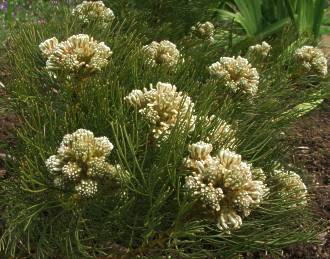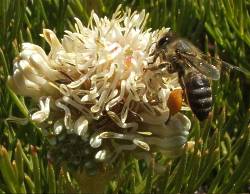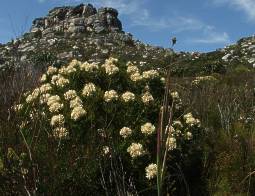Serruria glomerata
Serruria glomerata (L.) R.Br.
Family: Proteaceae
Common names: cluster spiderhead (Eng.); spinnekopbossie (Afr.)
Introduction
Serruria glomerata is an attractive fynbos shrub that belongs in the Protea Family and occurs naturally only on the Cape Peninsula. Its compact rounded shape, feathery foliage and fragrant, cream flowerheads make it a good garden subject.

Description
Description
Serruria glomerata is a compact rounded shrublet, 200-500 mm tall and up to 500 mm across. The plant arises from a single main stem. The leaves are 25-70 mm long and 30-60 mm wide, hairless and curve upwards. They are finely dissected into 20-25 cylindrical segments with sharp, fine points. The flowerheads are almost spherical, 25-50 mm long and 35-45 mm wide with up to three per branch. Each flowerhead is made up of 4-8 smaller heads of 20-40 flowers each. They are cream with a silky white sheen and have a sweet fragrance. Flowering occurs in late winter to spring (August to October) and the seeds are released about 2 months after flowering. The seed (more correctly termed the fruit) is a small hard, sparsely hairy, nut, with an elaiosome at the base. The elaiosome is an oily protuberance that is hidden while the fruit is attached to the flowerhead, but when it falls to the ground it is exposed.

Conservation Status
Status
Vulnerable. Serruria glomerata is endemic to the Cape Peninsula (meaning that it occurs naturally only in this region). Although locally common and occurring in fairly dense stands, this species has lost more than 30% of its population on lowland sites over the past 60 years, and is virtually extinct outside of nature reserves. The remaining populations are well conserved and are not declining, although the population at Kleinplaas Dam could be eliminated if the dam is enlarged. In addition to urbanisation, and possible development at Kleinplaas Dam, Serruria glomerata is threatened by invasive alien plants and alien ant species.
Distribution and habitat
Distribution description
Serruria glomerata is found on sandstone flats and slopes to 330 m altitude on the Cape Peninsula and Cape Flats. It is largely confined to Peninsula Sandstone Fynbos and is more common in the south. It used to occur on the Cape Flats but today is found only in the Tokai Plantation and Kenilworth Racecourse and has been re-introduced in the Rondevlei Bird Sanctuary. It can be seen elsewhere on the Peninsula, including the Noordhoek Flats, Else's Peak, Red Hill, Slangkop and Cape of Good Hope Nature Reserve. No viable populations remain outside of nature reserves.
Derivation of name and historical aspects
History
The genus Serruria is named after Dr. James Serrurier, professor of botany at Utrecht in the early 18th century. The specific name, glomerata, is Latin and means clustered into more or less rounded heads, referring to the flowers. Serrurias are commonly known as spiderheads, or spinnekopbosse in Afrikaans. They earned this name because many species have silky hairs on their finely divided leaves, which gives them a cobwebby appearance, as if spiders had spun their webs among the branches.

Serruria is a genus of 55 species endemic to the Western Cape. Members of the genus can be recognised by their dissected leaves which have cylindrical segments. The flowerheads can be solitary or multiple. Solitary flowerheads are always carried at the tip of the branch, and multiple heads are borne in the axils of the topmost leaves. Each flower has a conspicuous floral bract. Serrurias are confined to the winter rainfall area in the Western Cape, with the most easterly species extending as far as Mossel Bay.
Ecology
Ecology
Serruria glomerata plants are killed by fire and do not resprout. Their seeds have an elaiosome at the base, an oily growth on the seed that is attractive to ants and contains nutrients for them. The seeds drop about 2 months after flowering, and are carried off by ants to their nests where they consume the elaiosome but leave the rest of the seed uneaten. They survive underground, safe from fires and other predators like mice, and germinate after a fire has swept through the area. Seed dispersal by ants is known as myrmecochory.
Serruria glomerata is pollinated by insects.
Uses
Use
Serruria glomerata is not used in traditional medicine. Flowers last quite well in the vase.

Growing Serruria glomerata
Grow
Serrurias are quite easy to grow and are quick-growing but relatively short-lived and usually need to be replaced after a few years in cultivation. Serruria glomerata needs a sunny position, with free air circulation in well-drained (sandy or on a slope), acidic soil. Being relatively small, it is best grown on the edge of the bed or as part of a low border or shrubbery. It is suitable for rockeries or terraces as well as large pots and containers, provided drainage is good. Grow it in the fynbos garden, the Mediterranean garden, or in gardens on the Cape Flats that have acidic soil. It is also a candidate for the coastal fynbos garden, as in nature it grows in sight of the sea, although it is not suited to gardens that receive salty spray. Pinch the tips when young to encourage dense, bushy growth. When pruning, remember that Serruria glomerata is not a resprouter, and a branch that is cut below the leaf line will not send out any new growth. Like many members of the Protea Family, Serruria glomerata is susceptible to infection by the phytophthora root-rot fungus, so care should be taken to keep root disturbance to a minimum.
Serruria glomerata can be propagated by seed or cuttings. Collect seed from a mature flowerhead, either by repeated visits, or cover the flowerhead with a light cloth or stocking to catch the seeds as they drop, or remove the head after the last flowers have finished flowering and place in a tray in the drying room. Sow in late summer or early autumn when the days are warm but the nights are cold, as this temperature difference initiates germination. Alternatively, the seeds can be exposed to alternating periods of high and low temperatures to mimic the Cape autumn temperatures. Use a well-drained, sterile soil mix, cover lightly and place in a warm spot. Treat the seed with a fungicide that prevents both pre- and post-emergence damping off. Transplant the seedlings as soon as they are large enough to handle.
Take tip or heel cuttings in spring or autumn. Use a rooting hormone suitable for semi-hardwood cuttings and root in a well-aerated soil mixture in a propagation unit with underbench heating of ± 24°C and overhead mist. Rooting should occur from 5 weeks. After rooting, harden off for 4 weeks and then plant into pots or bags.
Grow Serruria glomerata seedlings and cuttings in a well-drained (sandy), acidic soil mix suitable for fynbos, e.g. a mixture of river sand, composted pine bark and loam. Do not feed with strong fertiliser, preferably feed with more frequent small doses of an organic liquid fertiliser. Plant out into the garden in autumn to allow the young plant to become established during the cool, wet winter before the onset of the hot, dry summer.
References
- Adams, T. 2003-07. Serruria cyanoides (L.) R.Br. (Proteaceae). Internet 2 pp. http://www.plantzafrica.com/plantqrs/serruriacyan.htm
- Jackson, W.P.U. 1990. Origins and meanings of names of South African plant genera. U.C.T. Printing Dept., Cape Town.
- Leistner, O.A. (ed.). 2000. Seed plants of southern Africa: families and genera. Strelitzia 10. National Botanical Institute, Pretoria.
- Plants of southern Africa: an online checklist. http://posa.sanbi.org
- Protea Atlas Project. http://protea.worldonline.co.za
- Raimondo, D., Von Staden, L., Victor, J.E., Helme, N.A., Turner, R.C., Kamundi, D.A. & Manyama, P.A. (eds) 2009. Red List of South African plants 2009. Strelitzia 25. South African National Biodiversity Institute, Pretoria.
- Rebelo, A. (Tony). 2001. Proteas. A field guide to the proteas of Southern Africa, edn 2. Fernwood Press & National Botanical Institute, Cape Town.
- Smith, C.A. 1966. Common names of South African plants. Memoirs of the Botanical Survey of South Africa No. 35.
- Trinder-Smith, T. 2006. Wild flowers of the Table Mountain National Park. South African Flower Guide 12. Botanical Society of South Africa, Cape Town.
- Vogts, Marie. 1982. South Africa's Proteaceae, Know them and grow them. Struik Publishers, Cape Town.
Credits
Alice Notten
Kirstenbosch National Botanical Garden
July 2010
Plant Attributes:
Plant Type: Shrub
SA Distribution: Western Cape
Soil type: Sandy
Flowering season: Spring, Winter
PH: Acid
Flower colour: White, Cream
Aspect: Full Sun
Gardening skill: Average
Special Features:
Horticultural zones









Rate this article
Article well written and informative
Rate this plant
Is this an interesting plant?
Login to add your Comment
Back to topNot registered yet? Click here to register.